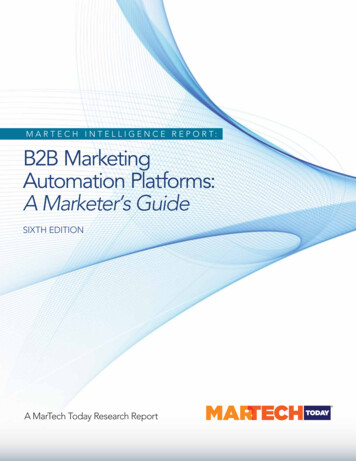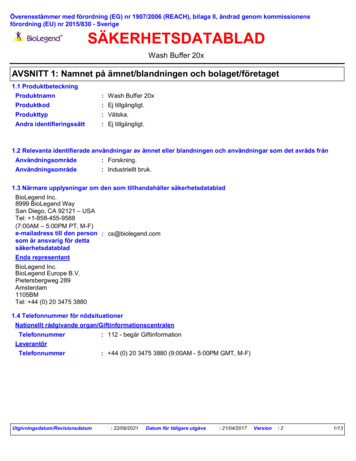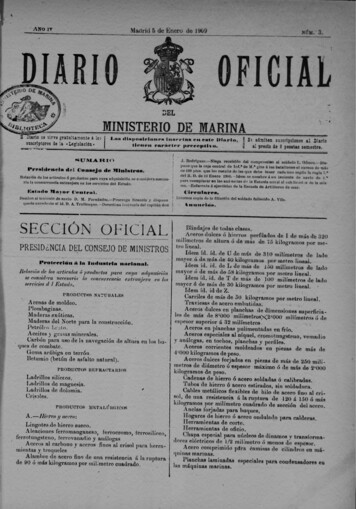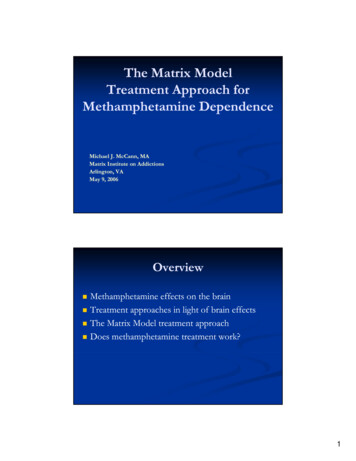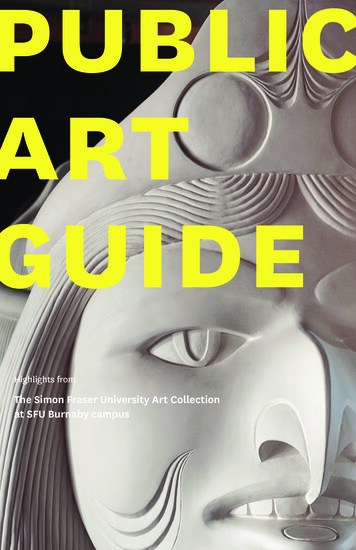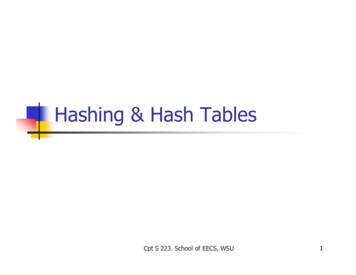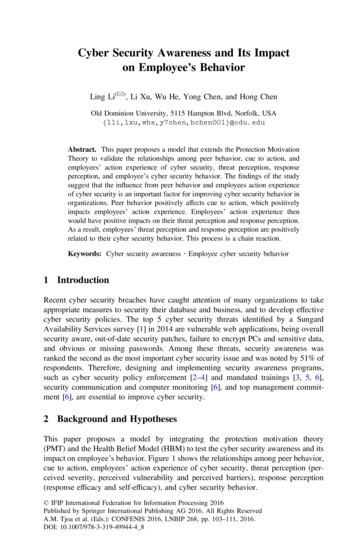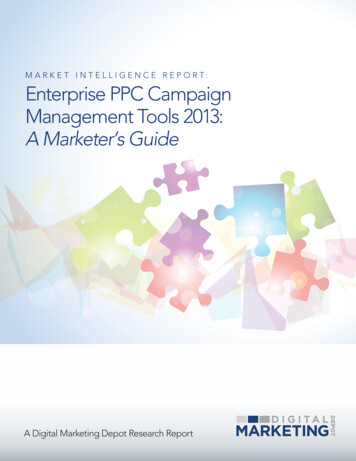
Transcription
M A R K E T I N T E L L I G E N C E R E P O R T:Enterprise PPC CampaignManagement Tools 2013:A Marketer’s GuideA Digital Marketing Depot Research Report
. .SEARCH. DISPLAY. SOCIAL. MOBILE. .revenueacquisitionmanagement.com. .@marinsoftware.WINTHE BATTLEFOR REVENUEONLINE. .
M A R K E T I N T E L L I G E N C E R E P O R T:Enterprise PPC Campaign Management Tools 2013: A Marketer’s GuideTable of ContentsScope and Methodology . 1PPC Market Overview . 2Table 1: U.S. Internet Advertising Market Revenue, 2011 vs. 2012. 2Table 2: U.S. Internet Advertising Market Share, 2011 vs. 2012. 3Adoption of PPC Campaign Management Tools is Accelerating. 4Table 3: “Increase in Search Marketers Licensing Third Party Tools for In-house Use, 2011-2012. 4Table 4: How In-House Search Marketers Manage Their PPC Campaigns, 2011 vs. 2012. 5Table 5: Selected PPC Ad Spend Under Management. 5Consolidation Slows as Market Matures. 6Table 6: Selected Paid Search Management Financing, 2012-2013. 6Point Solutions Build More Integral Role. 6Table 7: Selected PPC Campaign Management Point Solutions. 7PPC Campaign Management Market Trends. 7Trend #1: The Growing Importance of Google’s Product Listing Ads. 7Table 8: PLA Percent of Clicks vs. Text Ads. 8Table 9: Top Three Benefits of Attribution. 8Trend #2: Demand Increases for More Sophisticated Attribution . 8Trend #3: Google’s Enhanced Campaigns Force Marketers, Vendors to Update Bid Strategies and Tools . 9Enterprise PPC Campaign Management Tool Capabilities. 10Multi-model Attribution . 10Multichannel Data Integration. 10Supported Media. 11Table 10: Selected PPC Campaign Management Platform Capabilities. 11Integrated Local Search. 12Product Listing Ad Support. 12Pricing. 12Choosing an Enterprise PPC Campaign Management Tool. 12The Benefits of PPC Campaign Management . 12Step One: Do You Need an Enterprise PPC Campaign Automation Tool?. 13Step Two: Identify and Contact Appropriate Vendors . 13Step Three: Scheduling the Demo. 14Step Four: Check References, Negotiate a Contract. 14Conclusion. 15Vendor Profiles. 16Acquisio. 16Adobe Media Optimizer. 18HP Autonomy Optimost Campaign. 20DoubleClick Search. 22eSearchVision. 24IgnitionOne. 26Kenshoo. 28Marin Software. 30SearchForce. 32Resources. 34 2013 Third Door Media, Inc. http://digitalmarketingdepot.comEmail: whitepapers@digitalmarketingdepot.com
M A R K E T I N T E L L I G E N C E R E P O R T:Enterprise PPC Campaign Management Tools 2013: A Marketer’s GuideScope and MethodologyThis report examines the current market for enterprise Pay-Per-Click (PPC) campaign management tools and theconsiderations involved in implementing PPC software. This report answers the following questions: What trends are driving the adoption of enterprise PPC campaign management software?Who are the leading players in enterprise PPC campaign management software?What capabilities does enterprise PPC campaign management software provide?Does my company need PPC campaign management software?How much does PPC campaign management software cost?For the purposes of this report, PPC campaign management is defined as software that manages paid search campaigns,as well as paid social and paid digital display advertising. If you are considering licensing an enterprise PPC campaignmanagement software tool, this report will help you decide whether or not you need to. The report has been completelyupdated since its May 2012 publication to include the latest industry statistics, developing market trends, and new vendorprofiles and product updates. This report is not a recommendation of any PPC campaign management tool or company,and is not meant to be an endorsement of any particular product, service, or vendor.The companies chosen were selected based on their roles as industry leaders in paid search campaign managementsoftware, or their entire revenue comes from PPC campaign management technology and services. For a growing numberof vendors, PPC campaign management now includes paid search, display, and social media advertising. We have notincluded companies that offer PPC campaign management tools as part of a larger offering of services, i.e. larger agencieslike iProspect and iCrossing, nor have we included companies that focus primarily on PPC bid management software. All areviable options for managing digital advertising, but they fall outside the scope of this report.The report was prepared by conducting in-depth interviews with leading vendors and industry experts. Interviews tookplace in April and May 2013. These, in addition to third party research, form the basis for this report.Consulting Editor: David Rodnitzky, PPC Associates (http://ppcassociates.com)Research/Writers: LeeAnn Prescott, Karen BurkaEditors: Claire Schoen, Digital Marketing Depot (http://digitalmarketingdepot.com) 2013 Third Door Media, Inc. http://digitalmarketingdepot.com1Email: whitepapers@digitalmarketingdepot.com
M A R K E T I N T E L L I G E N C E R E P O R T:Enterprise PPC Campaign Management Tools 2013: A Marketer’s GuidePPC Market OverviewPaid search continues to be the foundation of digital marketing strategies and budgets, and the largest segment in theU.S. internet advertising market. Paid search revenues reached 16.9 billion in 2012, a 14.5% increase over 14.8 billion in2011, according to the Internet Advertising Bureau’s (IAB) Internet Advertising Revenue Report for the full-year 2012 (seeTable 1). In comparison, total display-related revenues, which include display/banner ads, rich media, digital video, andsponsorships, grew 9% to 12.0 billion in 2012.Table 1: U.S. Internet Advertising Market Revenue, 2011 vs. 2012(in millions)Ad Segment20112012% ChangeSearch 14,800 16,90014.5%Classifieds 2,600 2,400-8%Lead Generation 1,500 1,70011%E-mail 213 156-27%Mobile 1,600 3,400111%Display-related 11,100 12,0009%-Digital Video 1,800 2,30028%-Display/banner ads 6,800 7,70013%-Sponsorships 1,100 845-23%-Rich media 1,300 1,100-15%Total Internet Ad Market 31,700 36,60015.2%Note: Annual percent change may not be exact due to rounding.Source: Internet Advertising BureauPaid search maintained its share of internet advertising revenues in 2012, holding steady at 46.3% of the market (see Table2). Many digital ad formats are losing share to mobile advertising, which experienced triple-digit growth for the third year ina row. Mobile revenues grew to 3.4 billion in 2012, a 111% increase over 1.6 billion in 2011. Mobile’s share of the internetadvertising market has grown to 9% of revenues, up from 5% in 2011. 2013 Third Door Media, Inc. http://digitalmarketingdepot.com2Email: whitepapers@digitalmarketingdepot.com
M A R K E T I N T E L L I G E N C E R E P O R T:Enterprise PPC Campaign Management Tools 2013: A Marketer’s GuideTable 2: U.S. Internet Advertising Market Share, 2011 vs. ifiedsMobileMobileLead GenerationLead GenerationEmailEmail33%Note: Display advertising includes display/banner ads, rich media, digital video, and sponsorship.Source: IAB Internet Advertising Revenue Report, 2012Mobile and paid search lead a growing group of PPC digital media – which also includes display/banner ads and rich media– that are increasingly being managed by PPC campaign management tools. These media now account for 79% of theinternet advertising market.Adoption of PPC Campaign Management Tools is AcceleratingTo improve the efficiency, workflow, and profitability of their PPC campaigns, more in-house marketers are using third-partyPPC campaign management tools. Twenty-two percent of digital marketers license a third-party tool for in-house use, upfrom 12% in 2011, according to The State of Search Marketing Report 2012, co-sponsored by SEMPO and Econsultancy.Nearly one-third – 31% – of search-focused agencies license a third-party tool, a gain of two percentage points over 29% in2011 (see Table 3).Table 3: Growth in Use of Third-Party PPC Campaign Management Tools, e marketersSearch-focused agencies2011201112% 2013 Third Door Media, Inc. http://digitalmarketingdepot.com12%2012Source: SEMPO, Econsultancy420129%Email: whitepapers@digitalmarketingdepot.com
22%25%M A R K E T I20%N T E L L I G E N C E R E P O R T:EnterprisePPC Campaign Management Tools 2013: A Marketer’s Guide15%12%10%An additional 5%9% of in-house marketers work with an SEM agency that licenses a third-party tool, while 14% say theiragency providers have their own proprietary tools (see Table 4). The SEMPO report also found that the number of in-housemarketers managingcampaigns in-house using Excel or free tools provided by the search engines fell to 38% in 2012, from0%49% in 2011, and 53% in 2010. In-house marketersSearch-focused agenciesTable 4: How In-House Search Marketers Manage Their PPC Campaigns, 2011 vs. th tools provided by the search engines, or ExcelWith SEM services provider's proprietary toolWith a proprietary in-house solutionWith third party tool licensed for in-house useWith SEM services provider leasing a third-party toolSource: SEMPO, EconsultancyPPC campaign management tool vendors are the beneficiaries of these market shifts, as companies such as Acquisio,IgnitionOne, and Marin Software have demonstrated double-digit year-over-year growth in PPC ad spend undermanagement. (See Table 5).Table 5: Selected PPC Ad Spend Under Management(in millions)2011 Ad Spend UnderManagement2012 Ad Spend UnderManagement% ChangeAdobe 2,500 2,500—Acquisio 1,000 1,30030% 800 800—IgnitionOne 1,000 1,50050%Kenshoo 3,000 3,000—Marin Software 4,000 4,70017.5% 500 55010%VendoreSearchVisionSearchForceSource: Third Door Media 2013 Third Door Media, Inc. http://digitalmarketingdepot.com5Email: whitepapers@digitalmarketingdepot.com
M A R K E T I N T E L L I G E N C E R E P O R T:Enterprise PPC Campaign Management Tools 2013: A Marketer’s GuideConsolidation Slows as Market MaturesThe pace of consolidation in the PPC campaign management tools market slowed in 2012, as the market matured andseveral larger vendors instead sought financing to organically grow their businesses. Tel Aviv-based Kenshoo raised 12million in November 2012 in a venture round of funding intended to help expand the company’s geographic reach andincrease its product capabilities (see Table 6). To expand its presence in the enterprise market, Quebec-based Acquisioraised an undisclosed amount in August 2012 to pursue a growth strategy that includes geographic expansion and productdevelopment.In March 2013, Marin Software, the largest vendor in the PPC campaign management tools market, went public and raised 105 million, yielding a market valuation of 425 million. In February 2012, Marin raised 30 million, increasing the totalamount invested in the company to nearly 80 million.The two acquisitions of note in 2012 were Clickable’s acquisition by social media management solution Syncapse in Junefor a reported 33 million, and Acquisio’s August purchase of ScienceOps, which included the company’s AdMetricatechnology for optimizing Google Display Network bidding.Table 6: Selected Paid Search Management Financing, 2012-2013CompanyDateAmountInvestorsAcquisioAugust 2012Not disclosedTandem Expansion and Fonds de solidarite FTQKenshooNovember 2012 12MMTenaya Capital, Sequoia Capital, Sequoia Growth Fund, andArts AllianceMarin SoftwareMarch 2013February 2012 105MM 30 million(Series F)Initial Public OfferingTemasek, SAP Ventures, Benchmark Capital, Crosslink Capital,DAG Ventures, and Triangle Peak PartnersPoint Solutions Build More Integral RoleDespite the number of established and well-financed enterprise PPC campaign management companies, single-functiontools or point solutions are proliferating, providing sophisticated attribution or Product Listing Ad (PLA) support, forexample. These companies include ClearSaleing, Adometry, Convertro, and Visual IQ for attribution, and Adchemy for PLAs(see Table 7).Point solutions are playing a more important role in the market, as enterprises look for best-of-breed tools to work inconjunction with their enterprise solutions, and small and mid-size businesses (SMBs) seek affordable options to managePPC tasks. 2013 Third Door Media, Inc. http://digitalmarketingdepot.com6Email: whitepapers@digitalmarketingdepot.com
90,000 keywords in a typical search marketing account.That’s 90,000 opportunities to drive results for your business.We accept the challenge.Search can be challenging. Everyday, you juggle millions of keyword, bid, adand landing page combinations—and you need to turn them all into results.Luckily for you, we love a good challenge. We’ve designed DoubleClick Searchto make search work faster, smarter and better—and do it as part of yourbroader marketing efforts, thanks to native integration with the DoubleClickplatform. And with an estimated ROI of 195% from using our tool, marketersare seeing results. Working with DoubleClick Search means we’ll solve bigproblems, so you can focus on winning the moments that matter.Search Marketing is now faster, smarter, better.doubleclick.com/search 2013 Google Inc. All rights reserved. Google and the Google logo are trademarks of Google Inc.
M A R K E T I N T E L L I G E N C E R E P O R T:Enterprise PPC Campaign Management Tools 2013: A Marketer’s GuideTable 7: Selected PPC Campaign Management Point SolutionsVendorPPC Management onwww.adometry.comBoostCTRAd Text Optimizationwww.boostctr.comC3 w.convertro.comDataPopAd Text Optimizationwww.datapop.comVisual IQAttributionwww.visualiq.comSource: Third Door MediaPPC Campaign Management Market TrendsThe enterprise PPC campaign management market is being driven by a number of important trends, including:1. The growing importance of Google’s Product Listing Ads.2. Demand increasing for more sophisticated attribution.3. Google’s Enhanced Campaigns forcing marketers and vendors to rework tools, bid strategies.The following sections discuss each of these trends in more depth.Trend #1: The Growing Importance of Google’s Product Listing AdsIn October 2012, Google transitioned organic Google Shopping results to a paid model built on Product Listing Ads (PLAs).PLAs are search ads that include richer product information, such as product image, price, and merchant name, withoutrequiring additional keywords or ad text. They provide a richer, more visual search experience for end users and are basedon feeds submitted via Google’s Merchant Center.PLA share of both impressions and clicks, compared to text ads, grew rapidly after their introduction, boosted by thestrength of the online holiday shopping season. By the end of December 2012, PLA share of total impressions had grown60% to 6.1% from 3.9% in September, according to a report by Marin Software (see Table 8). For the full-year 2012, PLAclickthrough rates grew 210% to 6.6% in December from 2.1% in January, according to the Marin report, an indication thatend users are finding PLAs more relevant than text ads to their search queries.PPC marketers are still in the early stages of understanding how to optimize PLA bid strategies and campaigns, includingMerchant Center product feeds, targets, and promotions. Ultimately, PLAs will prod search marketers to more closely aligntheir paid and organic search strategies and tactics. PPC campaign management tools are attempting to accelerate thelearning curve by including management of PLA bidding and optimization. 2013 Third Door Media, Inc. http://digitalmarketingdepot.com7Email: whitepapers@digitalmarketingdepot.com
M A R K E T I N T E L L I G E N C E R E P O R T:Enterprise PPC Campaign Management Tools 2013: A Marketer’s GuideTable 8: PLA Percent of Clicks vs. Text Ads7.0%6.0%210%5.0%4.0%3.0%2.0%JANFEBMAR APR MAY JUNJUL AUGSEP OCT NOVDECSource: Marin SoftwareTrend #2: Demand Increases for More Sophisticated AttributionA proliferation of digital marketing channels and devices is fueling marketer demand for more sophisticated attributioncapabilities from PPC campaign management tools. Attribution is a statistical method that assigns credit for conversions todifferent digital touch points or channels along the conversion path. It is an imprecise science and marketers still struggle toaccurately understand how much credit or weight to assign to any particular touch point or channel along that path.Marketers agree, however, that attribution provides measurable benefits to the bottom line. A majority of marketers – 89%– that use attribution say it has had a positive impact on their business, according to Making Sense of Attribution, a surveyco-sponsored by Adobe Systems and Econsultancy. The top benefits include justifying marketing spend (70%), building abetter understanding of the customer journey (66%), and optimizing the media mix (58%). (See Table 9.)Table 9: Top Three Benefits of Attribution70%Justify marketing spend66%Build an understanding of the customer journey58%Optmize the media mix0%18%35%53%70%Source: Marin Software 2013 Third Door Media, Inc. http://digitalmarketingdepot.com8Email: whitepapers@digitalmarketingdepot.com
M A R K E T I N T E L L I G E N C E R E P O R T:Enterprise PPC Campaign Management Tools 2013: A Marketer’s GuideVirtually all of the PPC campaign management tools profiled in this reportprovide some type of conversion attribution that includes:1. A mechanism (such as a tracking pixel) that allows customers to trackactivity in channels other than paid search.2. A reporting feature to view the conversion path.3. An attribution model based on either last click, linear, proprietary, or userdefined models.However, as consumer use of multiple devices and channels to makepurchase decisions increases, digital marketers are looking for attributionmodels that more accurately assess the value of individual digital channels,devices, and online/offline experiences. Nearly half of marketers say mobileis driving increased interest in attribution within their organizations, accordingto the Making Sense of Attribution survey. Forty-three percent of marketerssay the same is true for social media.Nearly half of marketerssay mobile is drivingincreased interest inattribution within theirorganizations, accordingto the Making Sense ofAttribution survey. Fortythree percent of marketerssay the same is true forsocial media.PPC campaign management vendors have responded by expanding thenumber of attribution models available in their platforms, as well as their attribution capabilities. Dynamic attribution, forexample, assigns varying weights to specific touch points for each individual customer or prospect. There is also a growingmarket of point solutions, including ClearSaleing, VisualIQ, and Adometry attempting to provide digital marketers withbest-of-breed attribution technology.Trend #3: Google’s Enhanced Campaigns Force Marketers, Vendors toUpdate Bid Strategies and ToolsGoogle introduced Enhanced Campaigns in February 2012, a device-neutral bidding approach that merges desktop,tablet, and smartphone keywords. The introduction effectively forced digital marketers to embrace the mobile revolution byeliminating the ability to bid by device or platform.The introduction of Enhanced Campaigns created much debate within the digital marketing community. On the plusside, mobile has reached critical mass, with more than 125 million U.S. consumers now owning smartphones, and over 50million owning tablets, according to comScore. In the fourth quarter of 2012 alone, worldwide tablet shipments reached arecord total of 52.5 million units, according to IDC, a 75.3% year-over-year market increase. By pushing digital marketers toindiscriminately include mobile and tablet users in their campaigns, Google is acknowledging the size and strength of theaudience.But for advertisers who rely on the ability to target mobile devices, networks or operating systems, Enhanced Campaignsdiminishes the effectiveness of advertising on Google. PPC strategies that target keywords, ad groups, and ad copy bydevice must be completely reinvented, and the systems that support them must be re-engineered.Initially, marketers could opt in to Enhanced Campaigns, but in April 2013, Google announced a mandatory July 22ndcutover date for all advertisers. The vast majority of PPC campaign management platform providers have respondedby building Enhanced Campaign functionality into their user interfaces. This redevelopment has included rewriting bidalgorithms and multipliers, as well as creating new targeting tactics and strategies. Results for early Enhanced Campaignsso far show an increase in ad spend with little incremental gain from tablet users. As Enhanced Campaigns become moreprevalent, new best practices will emerge. 2013 Third Door Media, Inc. http://digitalmarketingdepot.com9Email: whitepapers@digitalmarketingdepot.com
M A R K E T I N T E L L I G E N C E R E P O R T:Enterprise PPC Campaign Management Tools 2013: A Marketer’s GuideEnterprise PPC CampaignManagement Tool CapabilitiesVirtually all enterprise PPC campaign management tools available today offer a core set of paid search tools andcapabilities that focus on: bid management; conversion attribution (multichannel); and campaign performance analytics and reporting.The platforms begin to differentiate by offering more advanced capabilities, often requiring additional investment, thatinclude but are not limited to: multi-model attribution;Google Product Listing Ad (PLA) support;multichannel data integration; andintegrated local search.The following section discusses some of these capabilities and the key considerations involved in choosing an enterprisePPC campaign management solution (see Table 10).Multi-model Attribution marketers are demandingmore sophisticated attributioncapabilities from PPC campaignmanagement tools.As previously mentioned in the Trends section of this report,marketers are demanding more sophisticated attributioncapabilities from PPC campaign management tools. Virtually all ofthe platforms profiled in this report offer some level of multichannelattribution that uses machine learning to assign value to differenttouch points along the conversion path. The platforms begin todifferentiate in the number of attribution models available andthe advanced capabilities they provide. For example, Kenshoo’s SmartPath is an add-on attribution tool that dynamicallychanges attribution weights for each individual conversion path. Adobe’s Media Optimizer collects data continuouslyacross five different attribution models for search, display, and social, allowing users to toggle between models and chooseoptimal spending allocations.Multichannel Data IntegrationMany digital marketers are experiencing “dashboard overload,” with separate paid search, SEO, web analytics, and socialmedia management platforms creating data silos and disparate campaign strategies within the organization. At the sametime, C-suite pressure to show a return on their digital investments has led more marketers to increase their demand forintegrated dashboards that allow them to link search data to other media, including display and social media.In response, PPC campaign management vendors have opened their Application Programming Interfaces (APIs) to externalsocial networks, web analytics, and CRM systems to provide more integrated analytics, reporting, and campaign execution.For example, several vendors partner with SEO tools such as BrightEdge and Conductor to allow side-by-side SEO and PPCdata analysis, or web analytics tools such as Adobe Analytics to provide integrated search and site data analytics. 2013 Third Door Media, Inc. http://digitalmarketingdepot.com10Email: whitepapers@digitalmarketingdepot.com
M A R K E T I N T E L L I G E N C E R E P O R T:Enterprise PPC Campaign Management Tools 2013: A Marketer’s GuideSupported MediaIn response to marketer demand for a more integrated approach to digital marketing, PPC campaign management toolsare offering services for a wider array of media. Specifically, search engines, social net
A Digital Marketing Depot Research Report MA RK ET INTE LLI GE NCE REPORT : Enterprise PPC Campaign Management Tools 2013: A Marketer's Guide


